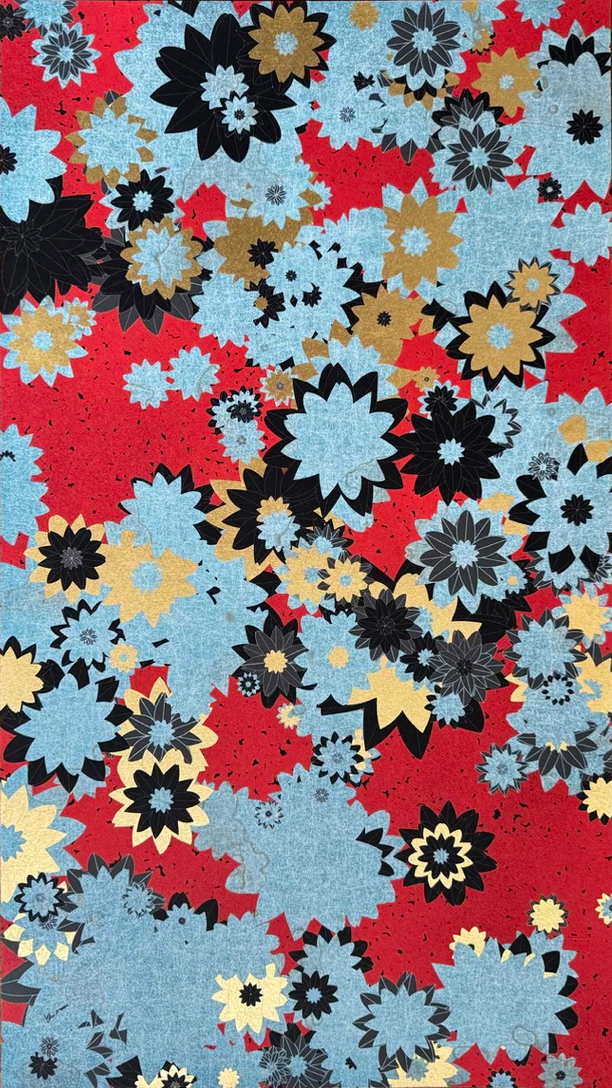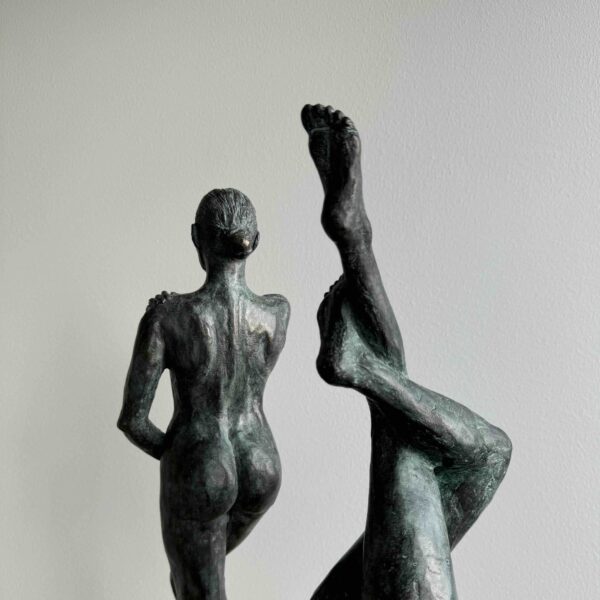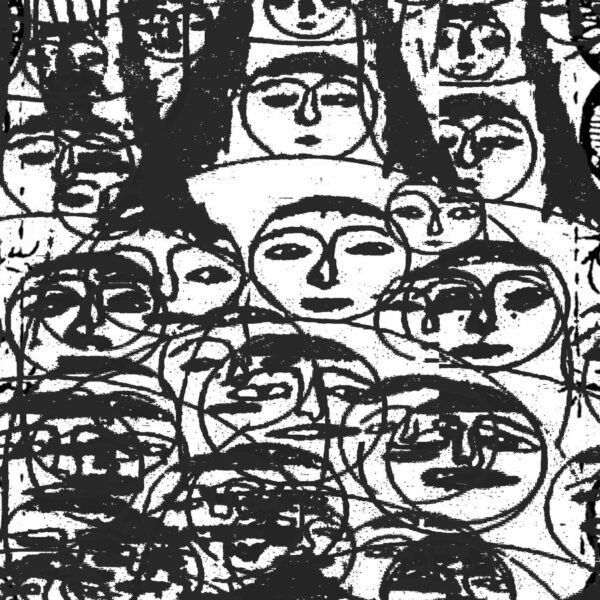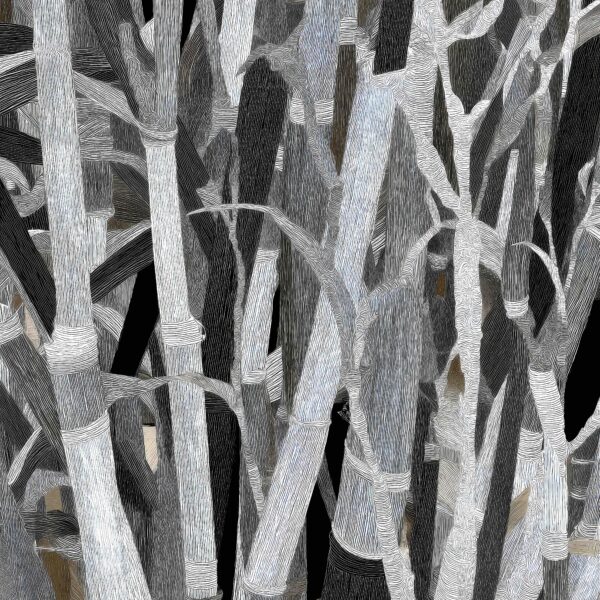The Skeuomorphic Techniques in Emily Xie’s Art
This article explores Emily Xie's innovative use of skeuomorphism to blend traditional art forms with digital techniques, challenging perceptions of materiality. Through detailed analysis of her works "Off Script #53", "Floral Pattern with Gold Foil", and "Aphelion Skies", we examine how Xie's art bridges the physical and digital realms, creating a unique sensory experience that is both familiar and strikingly new.

Emily Xie, a trailblazing visual artist based in New York City, seamlessly melds traditional art forms with cutting-edge digital techniques, challenging our perceptions of materiality in art. Her work invites viewers into a world where the tactile qualities of paper, textiles, and other physical materials are recreated and reinterpreted through the lens of digital technology. This unique approach, known as skeuomorphism, bridges the gap between the physical and digital realms, creating a sensory experience that is both familiar and strikingly new. Xie’s innovative approach will be highlighted in a special auction lot of three artworks by Emily Xie, offered for sale on August 14 as part of the partnership between Iconic Moments and AOTM Gallery for the Museum of Art + Light, showcasing her remarkable talent in a series of exclusive auctions.

Skeuomorphism in Art: A Historical Perspective
Skeuomorphism, the design principle of making digital interfaces resemble their real-world counterparts, has its roots in both art and design. This technique aims to create a sense of familiarity and ease for the viewer or user. In art, skeuomorphism can be seen as a way to bring the tactile qualities of traditional materials into the digital sphere, offering a bridge between the tangible and the virtual.
Emily Xie’s use of skeuomorphism goes beyond mere imitation. Her digital renditions of tactile materials like paper and textiles are not just about creating a visual resemblance but about evoking the sensory and emotional responses these materials traditionally elicit. By doing so, she engages with and challenges our preconceived notions of what digital art can be. This approach will be showcased in the partnership’s auctions, offering collectors a unique sensory experience.

Off Script #53: A Digital Collage
“Off Script #53” exemplifies Xie’s mastery of skeuomorphism. This piece draws inspiration from the early 20th-century collage art of Kurt Schwitters and Hannah Höch, as well as the vibrant cutouts of Henri Matisse. Matisse’s “The Snail” (1953) is particularly notable for its bold use of color and abstract shapes, creating a dynamic composition that feels both spontaneous and meticulously arranged.

The work’s layered textures and intricate shapes mimic the physicality of torn paper, creating an illusion of depth and tactility that is rarely achieved in digital media. In “Off Script #53”, Xie explores the boundaries between chaos and control, a theme also prevalent in the works of abstract artists like Wassily Kandinsky and Piet Mondrian. Kandinsky’s “Composition VII” is a masterful interplay of color and form, evoking emotions through abstract shapes and dynamic movement. Mondrian’s “Broadway Boogie Woogie” uses geometric precision and primary colors to create a rhythmic, almost musical composition.

To deepen this analysis, we can draw on the critical theory of Gilles Deleuze and his concept of “assemblage.” Deleuze’s idea that individual elements come together to form a cohesive whole while retaining their distinctiveness can be seen in the way Xie constructs her digital collages. Each fragment in “Off Script #53” maintains its individuality, yet contributes to the overall narrative of the piece, creating a dynamic interplay of form and meaning. This piece will be one of the highlights of the upcoming AOTM auction, providing a tangible link between traditional and digital artistry.

Floral Pattern with Gold Foil: Opulence and Craftsmanship
The “Floral Pattern with Gold Foil” highlights Xie’s fascination with the historical and cultural significance of textile patterns. This piece, with its vibrant floral motifs and gold accents, draws parallels to the work of William Morris and the Arts and Crafts movement, which sought to revive craftsmanship in an era of industrialization. Morris’s “Trellis” wallpaper design features intricate, interwoven patterns of flowers and leaves, emphasizing hand craftsmanship and natural beauty.

Xie’s digital rendition of textile patterns is more than a visual representation; it is an exploration of the rich sensory and emotional associations tied to these materials. The use of gold foil adds a layer of opulence and depth, reminiscent of Gustav Klimt’s iconic works like “The Kiss”, where gilded surfaces and intricate patterns create a sense of luxurious intimacy. The repetition and variation in the floral forms nod to traditional Japanese katazome techniques, a stencil dyeing method known for its precise and delicate patterns.

By elevating textile patterns within a digital framework, Xie aligns her work with feminist art theories that celebrate traditionally undervalued art forms. Judy Chicago’s “The Dinner Party” is a seminal work in feminist art, incorporating needlework and ceramics to honor women’s contributions to history and culture. Similarly, Xie’s digital textiles challenge the viewer to reconsider the boundaries of high and low art, blending the domestic with the avant-garde in a manner that is both innovative and deeply respectful of its historical roots. This exclusive print will offer collectors a chance to own a piece that encapsulates Xie’s unique blend of history and innovation.
Aphelion Skies: Capturing Light in the Digital Realm
“Aphelion Skies” exemplifies Xie’s ability to capture the ephemeral qualities of light and texture within a digital medium. This piece echoes the Impressionists’ fascination with light and atmosphere, yet it is rendered with a precision that is uniquely digital. Claude Monet’s “Impression, Sunrise” captures the transient effects of light on water, while Vincent van Gogh’s “Starry Night” uses swirling colors to convey the dynamic movement of the night sky.

The dynamic composition and bold colors in “Aphelion Skies” evoke the works of these masters, creating a sense of movement and life. The intricate detailing and layered textures reflect Xie’s mastery of digital tools, allowing her to emulate the depth and complexity of traditional painting techniques.
In this piece, Xie’s use of light and shadow creates a visual narrative that is both captivating and contemplative. The work invites the viewer to experience the transient beauty of a shadow cast at midday, rendered in a medium that is inherently permanent. This juxtaposition of the ephemeral and the enduring challenges our perceptions of time and materiality, echoing the themes explored by philosophers like Henri Bergson, who emphasized the fluidity of time and the interconnectedness of past, present, and future.

Engaging the Senses: The Role of Skeuomorphism in Digital Art
Emily Xie’s use of skeuomorphism is not just about visual mimicry; it is about creating a sensory experience that bridges the gap between the physical and digital realms. Her work engages with the viewer on multiple levels, challenging our perceptions of materiality and inviting us to explore the rich interplay of tradition and innovation.
In a digital age where the tactile and sensory experiences of traditional art forms are often lost, Xie’s work offers a refreshing and thought-provoking perspective. By incorporating elements of skeuomorphism, she not only honors the historical and cultural significance of these materials but also redefines their place in contemporary art. The partnership between Iconic Moments, AOTM Gallery, and the Museum of Art + Light will highlight these innovative techniques, showcasing how Xie’s art transcends traditional boundaries.
Conclusion
Emily Xie’s artistry lies in her ability to challenge and expand our perceptions of materiality through her innovative use of skeuomorphism. Her digital renditions of tactile materials create a unique sensory experience that bridges the physical and digital realms, inviting viewers to engage with her work in new and profound ways. As we look to the future of digital art, Xie’s contributions offer a compelling vision of how traditional and modern techniques can coexist and enrich each other, creating a dynamic and ever-evolving landscape of artistic expression. The upcoming auctions hosted by AOTM Gallery for Iconic Moments and the Museum of Art + Light will provide an unprecedented opportunity for collectors to experience and acquire Xie’s remarkable works, further solidifying her impact on the contemporary art scene.


